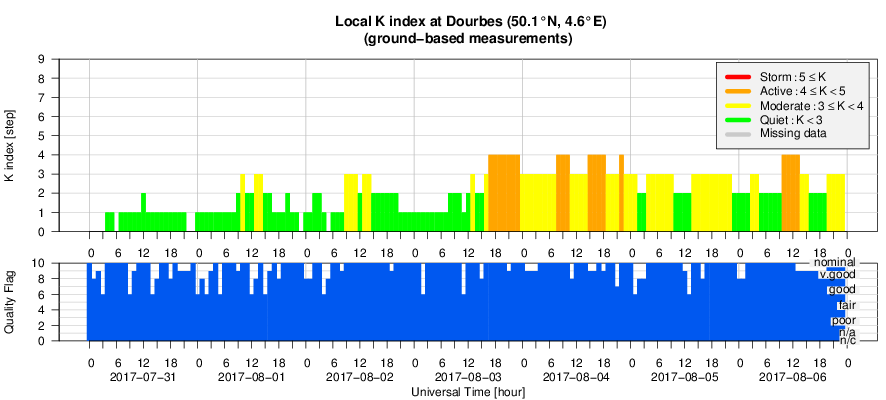- Table of Content
- 1.Eclipse: PROBA...
- 2.PROBA2 Observa...
- 3.Review of sola...
- 4.The Internatio...
- 5.Review of geom...
- 6.Geomagnetic Ob...
- 7.Review of iono...
- 8.Future Events
2. PROBA2 Observations (31 Jul 2017 - 6 Aug 2017)
3. Review of solar activity
4. The International Sunspot Number
5. Review of geomagnetic activity
6. Geomagnetic Observations at Dourbes (31 Jul 2017 - 6 Aug 2017)
7. Review of ionospheric activity (31 Jul 2017 - 6 Aug 2017)
8. Future Events
Eclipse: PROBA2, live from space
The Monday August 21 eclipse will transit the whole of North America. If you can't make it to there, no problem. We have a reporter, live from space: our satellite PROBA2.
Monday, 21 August 2017 will mark an important celestial event, a total solar eclipse. This will be a well-observed event from Earth, as the eclipse will transit the whole of North America. But, what if you are not in North America? We have a solution: the micro-satellite PROBA2 will be your reporter from space.
PROBA2’s orbit around Earth allows it to see the Sun almost continuously. Since one orbit takes only around 90 minutes, it can even see 3 (partial) eclipses! Another advantage is that PROBA2 doesn’t have to worry about the weather or clouds. PROBA2 ‘flies’ little more than 700 km above the Earth’s surface, well above the Earth atmosphere and the region where clouds are formed.
Our PROBA2 scientists and operators are ready to bring you the eclipse news from space asap on this news channel: http://proba2.oma.be/eclipse-August-2017
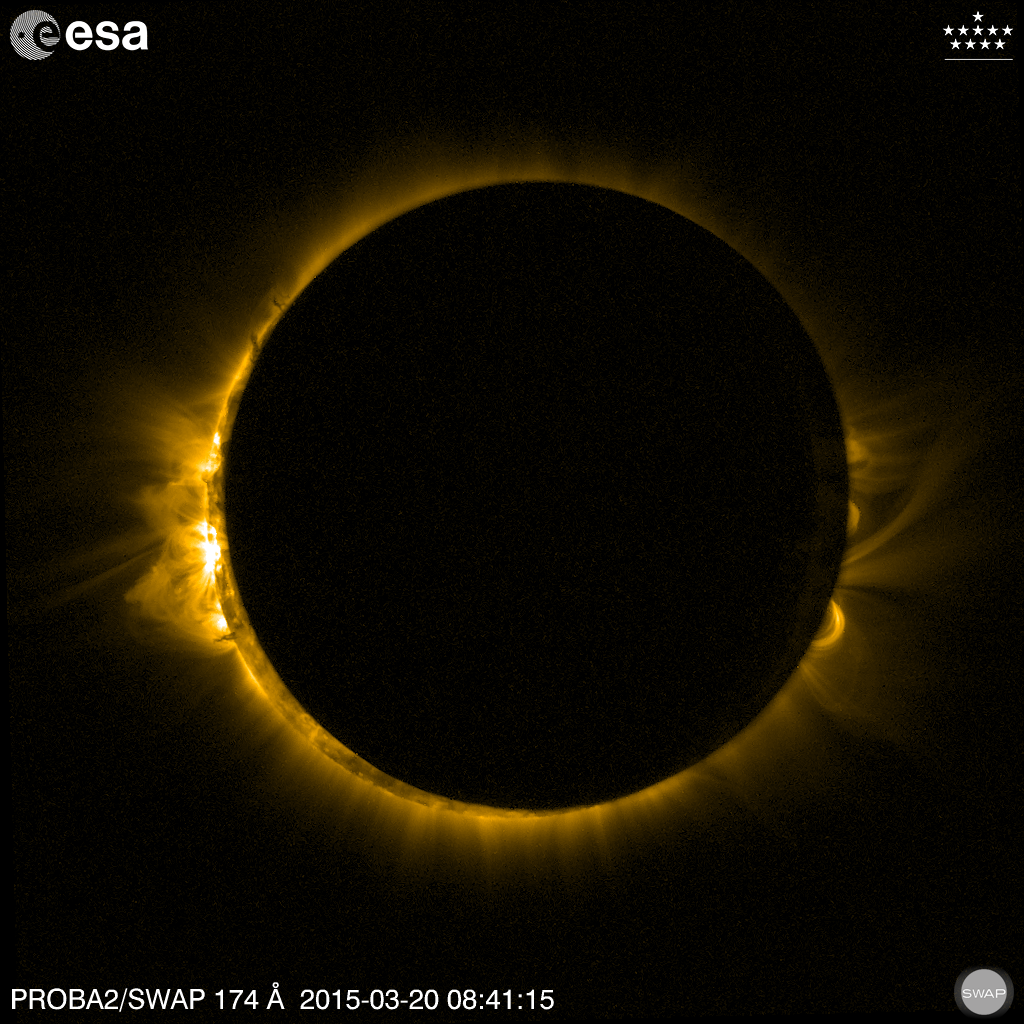
On 2015 March 20, PROBA2 observed a total solar eclipse as the spacecraft's orbit carried it through the darkest parts of the Moon's shadow.
PROBA2 Observations (31 Jul 2017 - 6 Aug 2017)
Solar Activity
Solar flare activity fluctuated between very low and low during the week.
In order to view the activity of this week in more detail, we suggest to go to the following website from which all the daily (normal and difference) movies can be accessed: http://proba2.oma.be/ssa
This page also lists the recorded flaring events.
A weekly overview movie can be found here (SWAP week 384):
http://proba2.oma.be/swap/data/mpg/movies/weekly_movies/weekly_movie_2017_07_31.mp4
Details about some of this week's events, can be found further below.
If any of the linked movies are unavailable they can be found in the P2SC movie repository here:
http://proba2.oma.be/swap/data/mpg/movies/
Tuesday Aug 01
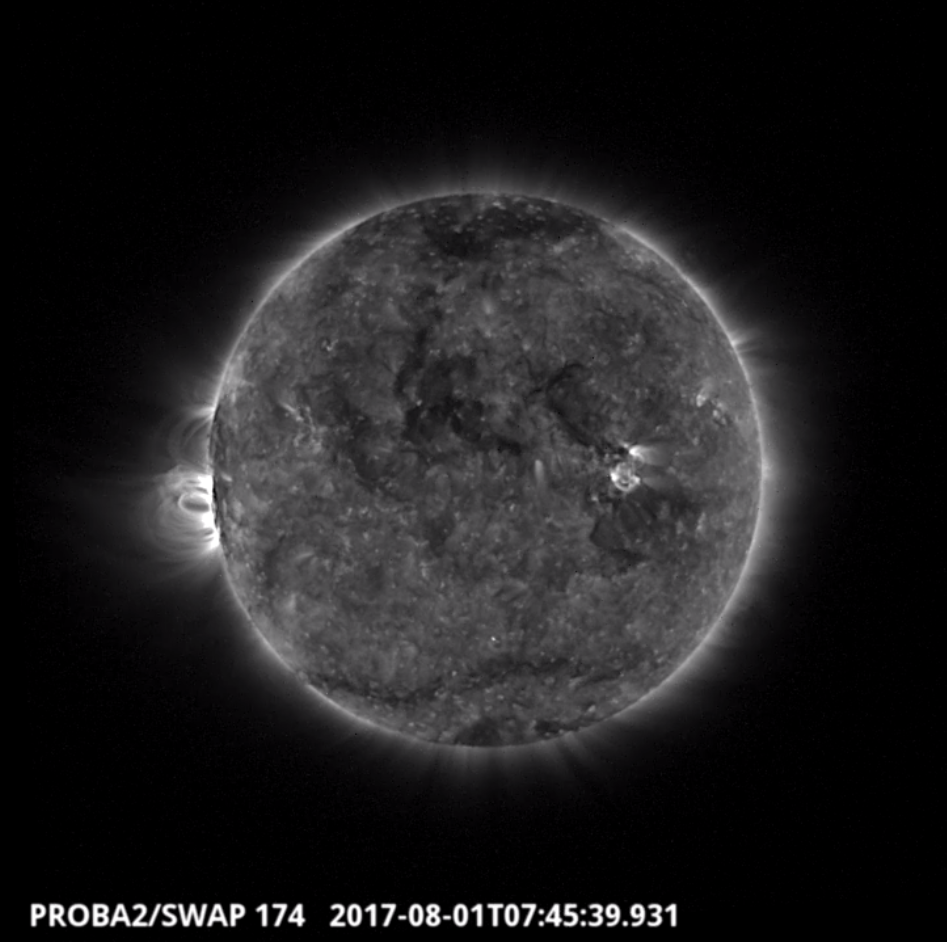
The largest flare of the week was a c-class (C1.4) flare on 01-Aug-2017, shown on the eastern limb of the Sun in the SWAP image above at 07:45 UT.
Find a movie of the event here (SWAP movie):
http://proba2.oma.be/swap/movies/20170801_swap_movie.mp4
Review of solar activity
The GOES X-ray background was below B2 level throughout the week. The only sunspot regions were NOAA 2669 (magnetically classified as 'alpha' on July 31 and August 1) and NOAA 2670 (beta, then alpha, is returning region NOAA 2665). Only one low C flare and some B flares were observed throughout the week, all produced by NOAA 2670.
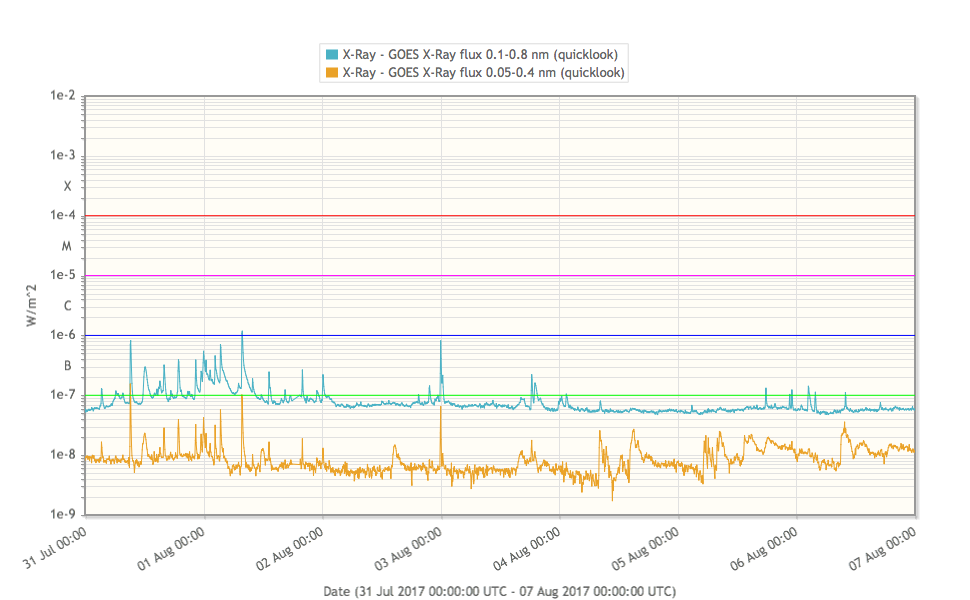
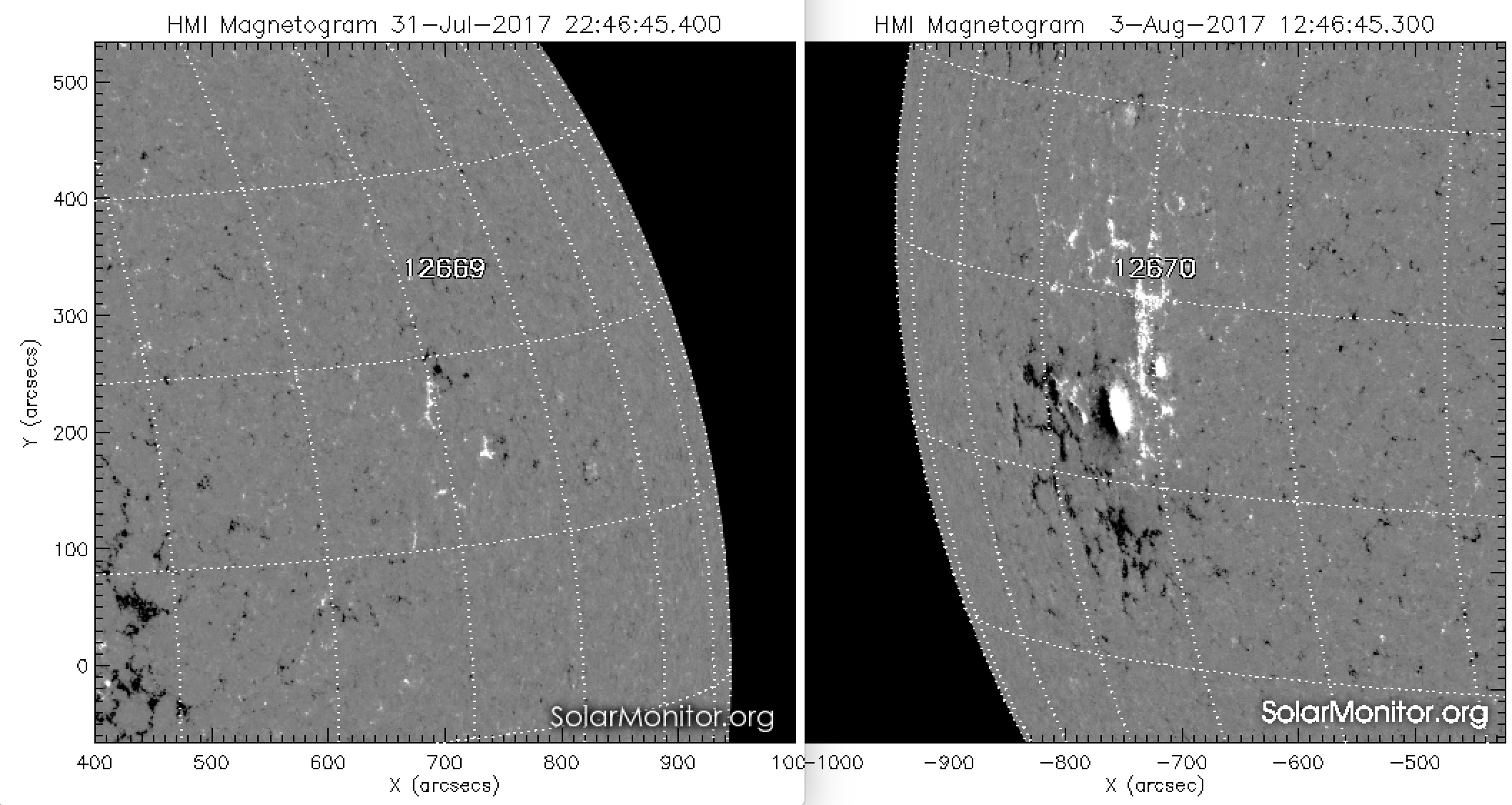
No earth-directed Coronal Mass Ejections (CMEs) were observed in available coronagraphic imagery. The greater than 10 MeV proton flux was at nominal levels.
The International Sunspot Number
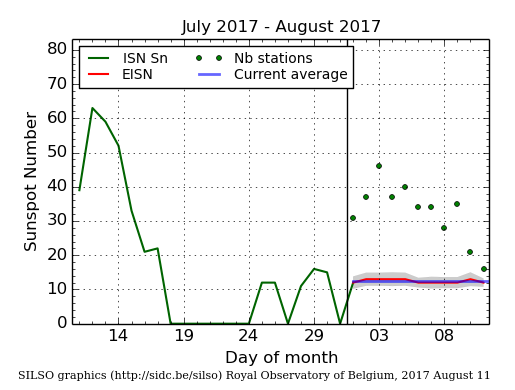
The daily Estimated International Sunspot Number (EISN, red curve with shaded error) derived by a simplified method from real-time data from the worldwide SILSO network. It extends the official Sunspot Number from the full processing of the preceding month (green line). The plot shows the last 30 days (about one solar rotation). The horizontal blue line shows the current monthly average, while the green dots give the number of stations included in the calculation of the EISN for each day.
Review of geomagnetic activity
The solar wind was influenced by two coronal high speed streams this week.
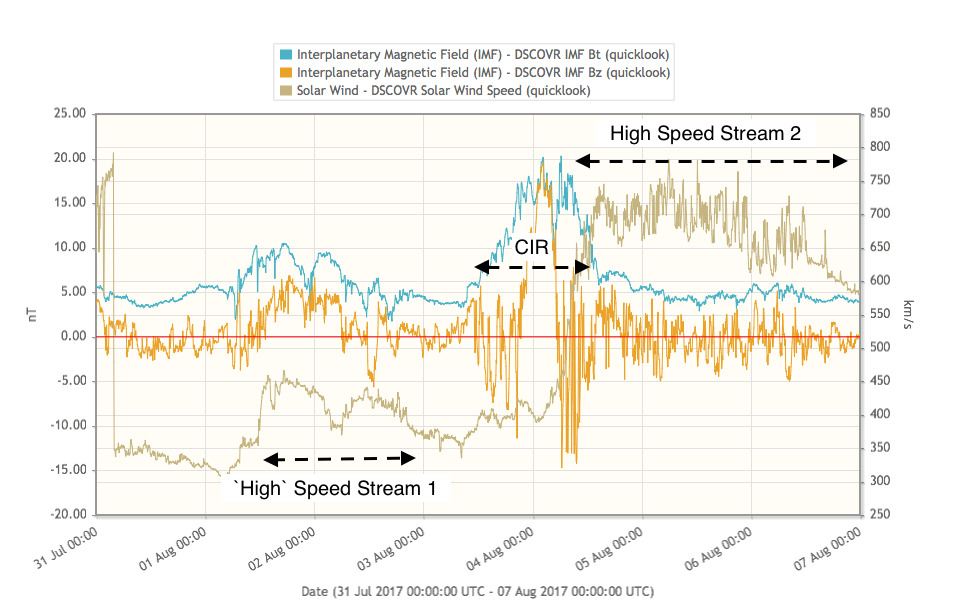
The first high speed stream was associated with a small negative coronal hole (see picture below) and arrived on August 1.
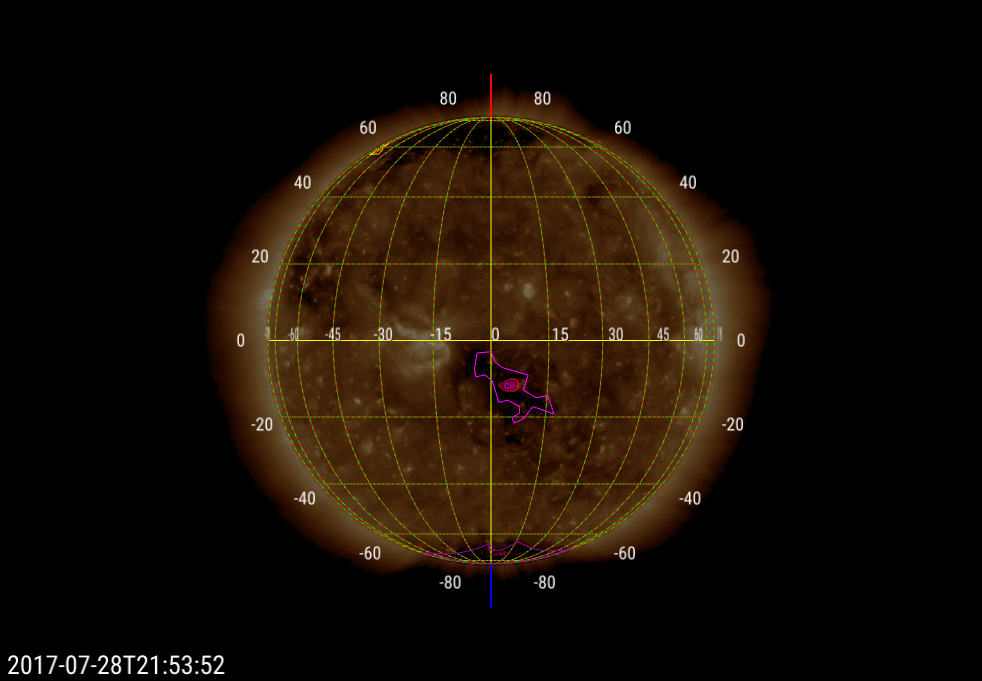
Throughout August 1 and 2, solar wind speeds up to 470 km/s were registered by DSCOVR, with a maximal Interplanetary Magnetic Field (IMF) magnitude of about 11 nT. The geomagnetic response was minimal: K Dourbes was maximal 3 on August 1 and 2.
The second high speed stream originated in a large positive coronal hole extending from the north pole to south of the equator (see picture below).
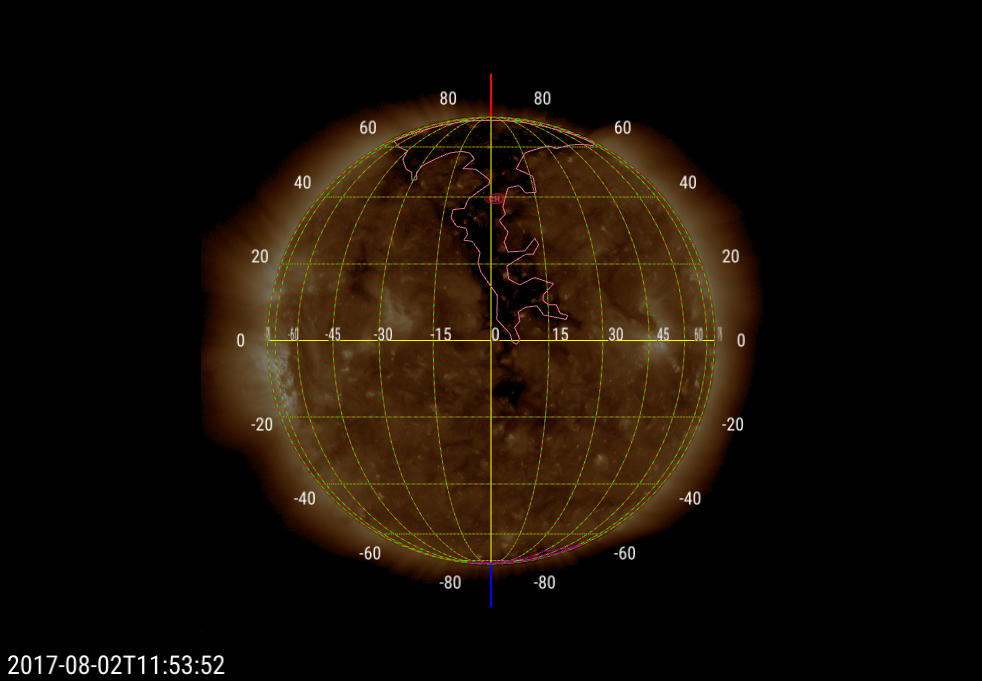
The associated Corotating Interaction Region (CIR) arrived on August 3, and the high speed stream on August 4. The solar wind speed measured by DSCOVR at the L1 point, reached values even above 750 km/s. The magnetic field imbedded in the solar wind, this is the Interplanetary Magnetic Field (IMF), reached values slightly above 20nT according to DSCOVR. Despite of the strong magnetic field, the z-component of the IMF was not consistently negative for long periods, and therefore, the geomagnetic levels at did not exceed K Dourbes = 4 (active geomagnetic conditions).
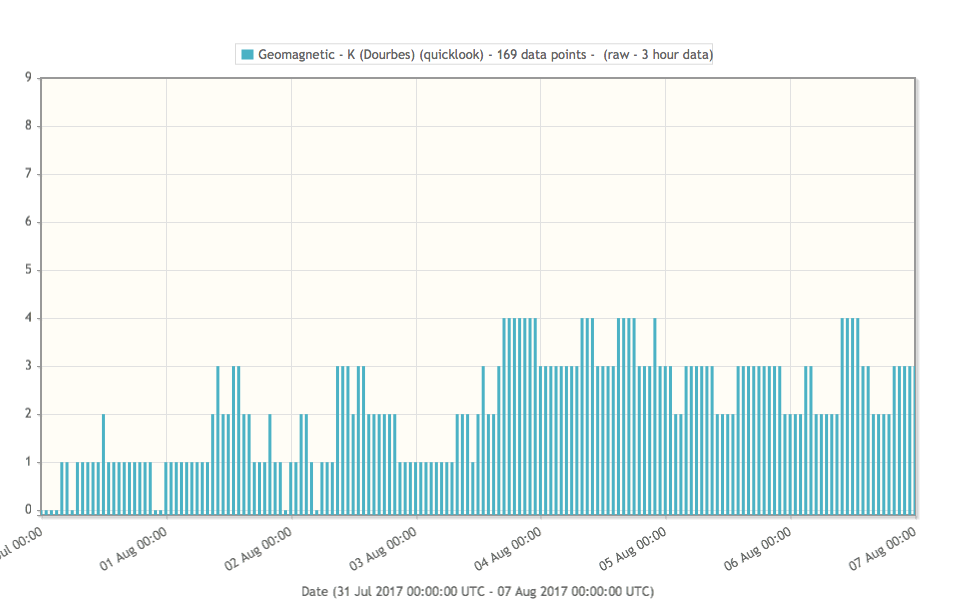
Review of ionospheric activity (31 Jul 2017 - 6 Aug 2017)
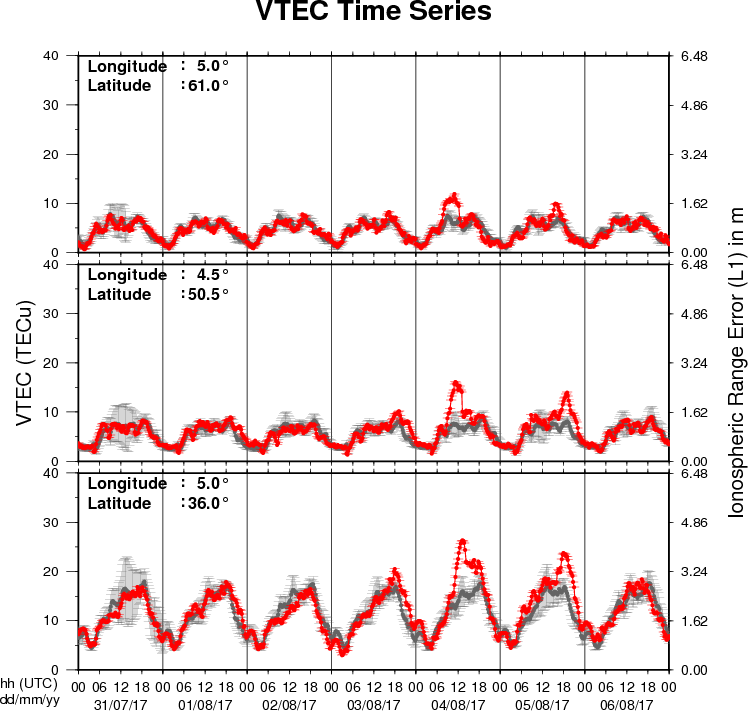
The figure shows the time evolution of the Vertical Total Electron Content (VTEC) (in red) during the last week at three locations:
a) in the northern part of Europe(N61°, 5°E)
b) above Brussels(N50.5°, 4.5°E)
c) in the southern part of Europe(N36°, 5°E)
This figure also shows (in grey) the normal ionospheric behaviour expected based on the median VTEC from the 15 previous days.
The VTEC is expressed in TECu (with TECu=10^16 electrons per square meter) and is directly related to the signal propagation delay due to the ionosphere (in figure: delay on GPS L1 frequency).
The Sun's radiation ionizes the Earth's upper atmosphere, the ionosphere, located from about 60km to 1000km above the Earth's surface.The ionization process in the ionosphere produces ions and free electrons. These electrons perturb the propagation of the GNSS (Global Navigation Satellite System) signals by inducing a so-called ionospheric delay.
See http://stce.be/newsletter/GNSS_final.pdf for some more explanations ; for detailed information, see http://gnss.be/ionosphere_tutorial.php
Future Events
For more details, see http://www.spaceweather.eu/en/event/future
URSI General Assembly in Montreal, Canada
Start : 2017-08-19 - End : 2017-08-26
For the thirty-second time since the inception of URSI, Radio
Scientists from across the world will get together for the URSI
General Assembly and Scientific Symposium. This triennial gathering
will take place from 19th to 26th of August 2017, in Montreal,
Canada. This conference is a unique opportunity to learn about
recent advances in all fields of Radio Science, as covered by all
ten URSI Commissions.
Among the different sessions, please note:
* 'Radio Science for Space Weather'
Conveners: M. Messerotti, V. Pierrard
* 'Remote Sensing and Modeling of the Earth's Plasmasphere
and Plasmapause'
Conveners: A. M. Jorgensen, V. Pierrard, B. Heilig
The abstract deadline is 30 January 2017
Website: http://www.ursi2017.org
2017 Joint IAPSO-IAMAS-IAGA Assembly in Cape Town, South Africa
Start : 2017-08-27 - End : 2017-09-01
The Joint IAPSO-IAMAS-IAGA Assembly, endorsed by the University
of Cape Town and the South African Department of Science and
Technology, will take place from 27 August to 1 September 2017 at
the Cape Town International Convention Centre (CTICC). Several IAGA
and IAMAS sessions are of Space Weather interests as well as the
joint session 'Space Weather throughout the Solar System: Bringing
Data and Models together'.
Website:
http://iapso-iamas-iaga2017.com/index.php
Workshops on Radiation Monitoring for the International Space Station in Torino, Italy
Start : 2017-09-05 - End : 2017-09-07
The Workshop on Radiation Monitoring for the International Space
Station is an annual meeting to discuss the scientific definition
of an adequate radiation monitoring package and its use by the
scientific community on the ISS. Types of instruments and research
topics need to be defined in order to optimise the radiation safety
of the ISS crew.
Website: http://wrmiss.org/
International Workshop on Solar, Heliospheric & Magnetospheric Radioastronomy in Meudon, France
Start : 2017-11-06 - End : 2017-11-10
Jean-Louis Steinbeg has been one of the major pioneers in
radioastronomy. Co-founder of the Nançay Observatory, he
has actively participated to, an inspired a large number of radio
instruments on many international space missions. Jean-Louis
Steinberg is the founder of the Space Radioastronomy laboratory of
the Paris Observatory in 1963. Later on, this laboratory widened
its science interests and became the DESPA (1971) and then the
current LESIA (2002) which is one of the major space sciences
laboratories in France. The aim of this workshop is to cover the
science topics which Jean-Louis Steinberg has promoted during his
career, focusing on Solar, Heliospheric & Magnetospheric
radioastronomy & physics. This will be done by covering both
observations from either ground facilities (NDA, RH, LOFAR, Artemis
etc ...) or space missions (ISSEE, Ulysses, WIND, CLUSTER, STEREO,
CASSINI, JUNO etc ...) and models/theories. A series of invited
talks is also foreseen to cover the new developments in the
discipline which may come with the future facilities such as Solar
Orbiter, Solar Probe Plus, JUICE, JUNO, LOFAR+, SKA etc ....
This workshop will also be the opportunity to remember both the
extraordinary personal & professional lifes of Jean-Louis
Steinberg especially for new generation of scientists. At the
occasion of this workshop it is also expected that the Building 16
(historical Space Sciences building) on the Meudon campus will be
renamed "Building Jean-Louis Steinberg".
Website:
https://jlsworkshop.sciencesconf.org/
European Space Weather Week 14
Start : 2017-11-27 - End : 2017-12-01
The ESWW is the main annual event in the European Space Weather
calendar. It is the European forum for Space Weather as proven by
the high attendance to the past editions. The agenda will be
composed of plenary/parallel sessions, working meetings and
dedicated events for service end-users. The ESWW will again adopt
the central aim of bringing together the diverse groups in Europe
working on different aspects of Space Weather.
Website:
http://www.stce.be/esww14/
